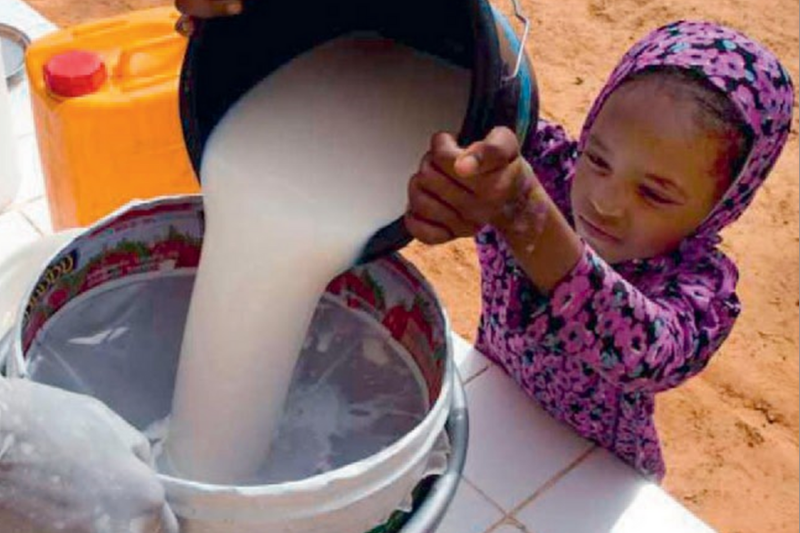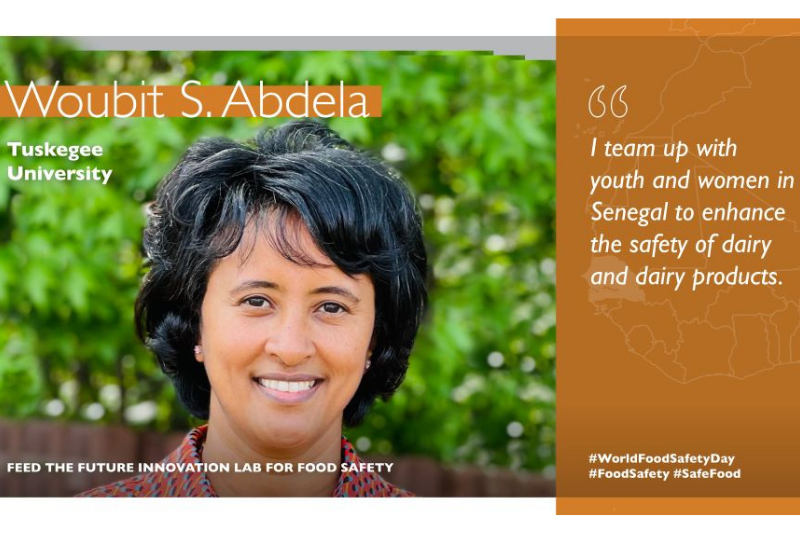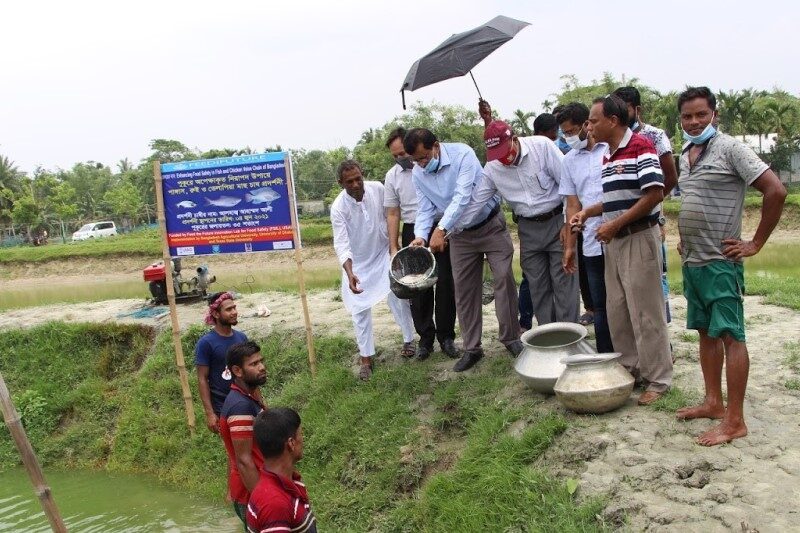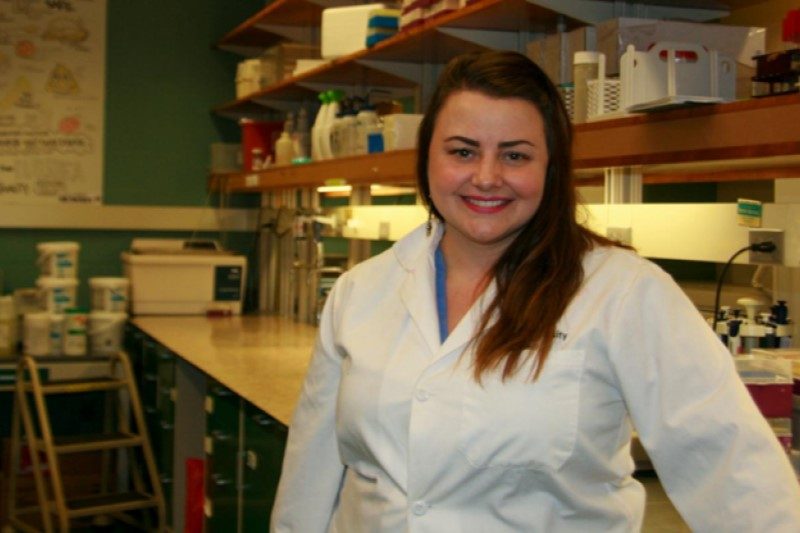Posted on April 26th, 2023 in In the News
Translated and lightly edited from a story by V.C. Bakribi published on Agriview24.com.
“We all have to do our best to produce nutritious and safe food. Fish is a very nutritious food, and we get good meat from fish. The current government is also giving special importance to this issue,” said Deen Mohammad Dinu, agriculturist and director of the Public Relations and Publication Department at Bangladesh Agricultural University (BAU), at a recent Feed the Future Innovation Lab for Food Safety (FSIL) outreach event. “If safe fish production increases, it will contribute to earning foreign exchange through exports. This will greatly improve the economy of the country.”
Dinu was one of several dignitaries who attended the exhibition and outreach program titled “Enhancing Food Safety in the Fish and Poultry Value Chains of Bangladesh,” which was held on Thursday, March 9, 2023, at Rupali Hatchery, Muktagachha Upazila, Mymensingh.
The Bangladeshi project lead is BAU Professor of Agricultural Economics Dr. Md. Saidur Rahman. He shared that the project is being conducted over three and a half years, starting in 2021, by a team of researchers from Texas State University, BAU, and Dhaka University. Dr. Madan Mohan Dey, chair and professor in the Department of Agricultural Sciences at Texas State University, serves as the principal investigator of this project.
Dignitaries present at the event included BAU Vice-Chancellor Lutful Hasan; Dean of the Faculty of Agricultural Economics and Rural Social Sciences Khandaker Mostafizur Rahman; Dean of the Faculty of Fisheries Md. Abul Mansoor; Acting Director General of the Bangladesh Fisheries Research Institute (BFRI) Md. Anisur Rahman; and Deputy Director of the Mymensingh Fisheries Department Jahangir Alam.
Saidur Rahman shared updates on the project activities, starting from feed preparation to hatching, monitoring the growth and weight of fish over time, regular inspection of ponds, harvesting and selling fish, and future work plans. A discussion was subsequently held on the hatchery premises.
Dr. K.H.M. Nazmul Hossain, BAU professor of microbiology and hygiene, highlighted the project’s analysis of contaminants and said that there is a misconception that the fish in the market is bad or the fish is contaminated and the presence of heavy metals is high. But tests for bacteria and heavy metals (arsenic, lead, cadmium, chromium) in Muktagacha market fish and fish farmed in the project’s Rupali Hatchery showed that fish from both locations had lower levels of bacteria and heavy metals than the maximum acceptable levels. However, the amount of heavy metals in the project’s hatchery cultured fish was lower than that of the market fish. In addition, the project is also addressing the role of women in safer fish production.
“Women have a role in all activities of fish farming, but they have no decision-making power,” said Dr. Samina Luthfa, Professor in the Department of Sociology at Dhaka University. “Women have a great opportunity to contribute more to safe fisheries, but they must be given that opportunity. Women’s opinion will be given importance.”
More than 20 fish entrepreneurs and farmers also attended the meeting.
“In many cases, we make mistakes in selecting correct and standard fry,” said fish farmer Saurabh Das. “At the end of the year, production is low in many cases. We don’t really know which foods are good for fish. If someone says that this food is good or if someone sees that using a food has increased production, we use that.”
“But I don’t know if it is safe or not. If the relevant authorities play an important role in this matter, we will get safe fish food and fish,” he said.
According to Saidur Rahman, the project’s purpose is to understand current food safety knowledge among producers and consumers, especially for safe fish and chicken production, marketing and consumption, their attitude towards food safety, and the level of practicing it in real life. Accordingly, the project will offer trainings and workshops and will encourage government stakeholders to formulate effective policies for implementation of food safety practices.
In addition, the project is producing pangas, tilapia, and roe fish using safer fish feed and best management practices. Researchers will also assess consumer demand or how much consumers are willing to pay to obtain fish produced using safer management practices, compared to conventional practices, through an experimental auction process. Results will be shared with policy makers to inform actions to promote safer fish farming.
Saidur Rahman said that to achieve this objective, the researchers associated with the project have cultivated tilapia and pangas in two ponds in Phulpur, Mymensingh, and cotton fish in one pond in Muktagacha using safer management practices. The feed is prepared through a local feed manufacturing facility as per the advice of fish scientists where no antibiotics, hormones, growth promoters or any feed additives are used.
The event was organized to showcase and publicize the project’s activities to individuals who can play an effective role in policy making as well as fish farmers interested in learning about safer fish production.
Posted on September 15th, 2022 in In the News, Researcher Profiles
Every class taught by Andrea Bersamin, professor in the Department of Biology and Wildlife at the University of Alaska Fairbanks, begins with a rundown of her favorite childhood reading materials.
At a young age, she begged her mother for a subscription to Bon Appétit, a monthly cooking and culinary arts magazine, and had a unique fascination with the world’s best-selling medical textbook, the Merck Manual of Diagnosis and Therapy. She and her sister reveled in a series of detective books, which instructed the reader on how to become a skilled sleuth.
Continue reading on Agrilinks
Posted on June 13th, 2022 in In the News
Translated from a story published by SHOBUJ BANGLADESH.
An auction was organized in the offices of the Agriculture, Economics, and Rural Sociology faculty of the Bangladesh Agricultural University to assess the value of food safety in fish and chicken in Bangladesh. The auction was organized by the Bangladesh Agricultural University, Dhaka University, and Texas State University together with financing from USAID. The research team organized this auction as a strategy to determine the market price of fish and chicken that are produced safely through this project.
Researchers stated that safely cultivated fish are attracting buyers and it looks like farmers will be able to sell fish that they produce at their desired price. At the beginning of the event, Dr. Madan Dey joined virtually from the United States. He said, “the purpose of this project is to raise fish and chicken while properly maintaining food safety and quality.” After this, project director Dr. Md. Saidur Rahman highlighted the agenda and the rules of the auction for the buyers present. He said, “fish cultivated under the project along with fish bought directly from the market are available here.”
He asked buyers to determine the price of the cultivated fish according to the market price. After that, two samples each of Tilapia and Pangas fish were shown to the buyers. Out of these two one was bought from the market and the other one was specially cultivated fish. At the first stage of the auction, the buyers were asked to determine the price of a fish that looked good based on its size and color. During this time buyers observed the fish in detail and submitted their maximum price in sealed envelopes.
In the second stage, buyers were asked to determine the price of specially cultivated fish based on information from the laboratory regarding the quality of the fish. During this time, Dr. K. H. M. Nazmul Hussein Nazir of the Department of Microbiology and Hygiene of the Bangladesh Agricultural University highlighted information from the laboratory for the buyers present and answered their various questions. Research shows that there are less bacteria present in safely cultivated fish. Sometimes there may even be no bacteria at all. There seem to be more bacteria present in unsafely cultivated fish.
After this, the results of the action were announced. The person who offered the highest price in the action was declared the winner. To purchase the fish, that person was asked to pay the second-highest price for it.
Teachers, office employees, and neighborhood businessmen including nearly 50 general buyers were present at the auction. Dr. Md. Akhtaruzzaman, a member of the research team, Dr. Samina Luthfa, an associate of the Faculty of Sociology of Dhaka University, and nearly 50 buyers were present. In stage one Dr. Md. Abul Haem from group “A” became the winner by offering 250 taka for specially cultivated Tilapia and 200 taka for Pangas fish. He had to pay the second-highest price of 200 taka for Tilapia and 150 taka for Pangas fish.
From the next group “B” Janab Md. Mohsin and Asif Mahmud were the winners for Tilapia and Pangas fish respectively and Abu Taher was the winner from group “C”. Zannatul Naima was the winner from the women’s group. Professor Dr. Chadeka Haque of group “A” was the winner after learning the results of the lab test. Abdullah Shafiq Md. Shahidul Islam and Asif Md. Hamza Talukdar from group “B” and Ariful Islam Babul, Abdul Kayem, Jainal Abedin from group “C” were the joint winners.
Dr. Md. Saidur Rahman, the principal co-coordinator of the project said that this project is being financed by the Feed the Future Food Safety Innovation lab. Through this project, producers are gaining an interest in cultivating fish free of bacteria and other hazards. The researchers also said that this will ensure health and safety through the use of safe fish.
Posted on September 18th, 2021 in In the News
Translated from a story published in Le Soleil in August 2021.
Improve the resilience of the dairy value chain by strengthening public-private partnership. This is the goal of the project launched yesterday in Dakar by the Food Technology Institute in collaboration with USAID.
Food security, the milk value chain, public-private partnerships and gender. These dimensions are what guide and ground the project “Strengthening capacity for sanitary food security in Senegal: Improving the resilience of the dairy value chain by strengthening the public-private partnership” launched yesterday in Dakar. Unfolding in the country’s northern zone (in the regions of Saint-Louis, Matam and Louga), the project seeks to benefit from the “enormous potential for milk production by the large amount of livestock in the area,” said Mamadou Amadou Seck, Director General of the Institute for Food Technology (ITA – Institut de Technologie Alimentaire).
He observed, however, and deplores the fact, that the “sanitary quality of the milk, as well as its availability, are not entirely reliable.” Moreover, to justify the urgency of setting up a project over a period of three and a half years, he notes the estimates of the World Health Organization (WHO) indicating that Africa is “confronted with the highest burden of food-borne diseases per inhabitant, with around 137,000 deaths and 91 million persons suffering from acute disorders each year.”
“The WHO estimates that 70% of the disease burden is caused by bacteria, parasites and chemical hazards present in certain products and nutritious foods with high added value, such as dairy products,” he added.
Training the actors
“The overall objective is to raise the awareness of stakeholders to the problems of the food security of milk and derivative products, as well as their impact on public health,” explained Dr. Younoussa Diallo, in charge of research and Head of the Division of Control and Quality at ITA.
As he sees it, attaining this objective should be accomplished by developing and conducting grassroots training and capacity-building programs. But also by providing the food industry with knowledge on cost-benefit approaches to implementing a sanitary food security management system.
The need to “give consumers healthy and nutritious products demands improvement in milk processing,” Dr Diallo underscores.
The project, with financing on the order of US$ 700,000 (about 350 million FCFa) by USAID, focuses on improving awareness of food security problems in the value chain for milk and derivative products, and the creation of a network of professionals who are well-equipped to promote food security in Senegal.
This also involves developing autonomy for women and increased participation by young people. Other outcomes are also expected, having to do with “improving nutrition, in correlation with human health, and reducing and attenuating risks to achieve resilience.”
The partnership calls for the involvement of research institutes (ITA, ISRA, CNDN) supported by Senegalese and American universities (University of Georgia, Tuskegee University, UCAD, USSEIN), the Senegalese Association for Standardization and Guidance of Livestock Industries.
The gender aspect derives from a strategy that seeks to “understand and fill gaps in the knowledge of women producers engaged in artisanal processing on contamination and diseases related to dairy products,” according to Dr Diallo. It will also involve integrating this question of gender into management.
Author: Ibrahima Khaliloullah Ndiaye
Translation by Alboum
Posted on June 7th, 2021 in In the News
We believe investing in data-driven, locally sustainable food safety practices and policies will break cycles of disease and malnutrition. On World Food Safety Day, we highlighted Food Safety Innovation Lab colleagues working for safe and healthy diets around the world.
Follow us on Twitter
Posted on June 5th, 2021 in In the News
Researchers from the United States and Bangladeshi universities, as part of their study on consumer willingness to pay more for safer fish and chicken, have stocked a farmer’s pond in Muktagacha of Mymensingh district with rohu fingerlings.
Continue reading on The Business Standard
Posted on December 10th, 2019 in In the News
Is there value in investing in the development of other countries when so many Midwestern farmers will likely face a deficit this year? Should international investments be reallocated to benefit local family farms struggling to pay their bills?
The U.S. invests about $49 billion in the development of international economies, according to the U.S. Agency for International Development, or USAID. While that money would greatly benefit domestic farmers today, investing internationally can bring major long-term benefits and solutions to local farmers and can provide new sources of revenue for future generations. It also helps reduce costs for the U.S. in the future.
Continue reading on FarmProgress.com








